Organization Development and Change
VerifiedAdded on 2020/04/07
|13
|2670
|155
AI Summary
This assignment delves into the field of organization development and change. It covers key concepts such as learning and development needs analysis, training effectiveness, knowledge transfer, and program evaluation. The document outlines steps involved in developing a learning plan, including identifying learning needs, designing session plans, assessing learning outcomes, and evaluating the overall program.
Contribute Materials
Your contribution can guide someone’s learning journey. Share your
documents today.
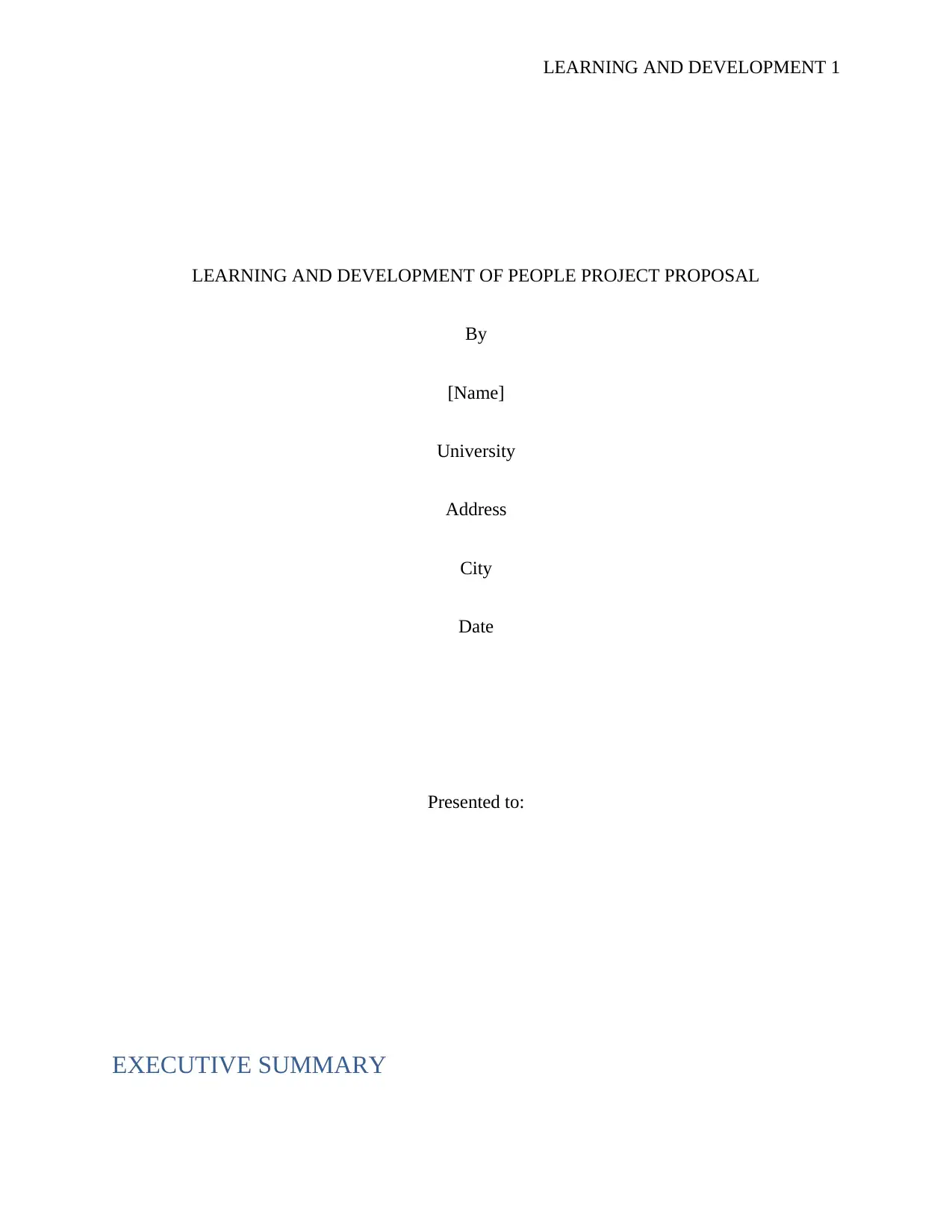
LEARNING AND DEVELOPMENT 1
LEARNING AND DEVELOPMENT OF PEOPLE PROJECT PROPOSAL
By
[Name]
University
Address
City
Date
Presented to:
EXECUTIVE SUMMARY
LEARNING AND DEVELOPMENT OF PEOPLE PROJECT PROPOSAL
By
[Name]
University
Address
City
Date
Presented to:
EXECUTIVE SUMMARY
Secure Best Marks with AI Grader
Need help grading? Try our AI Grader for instant feedback on your assignments.
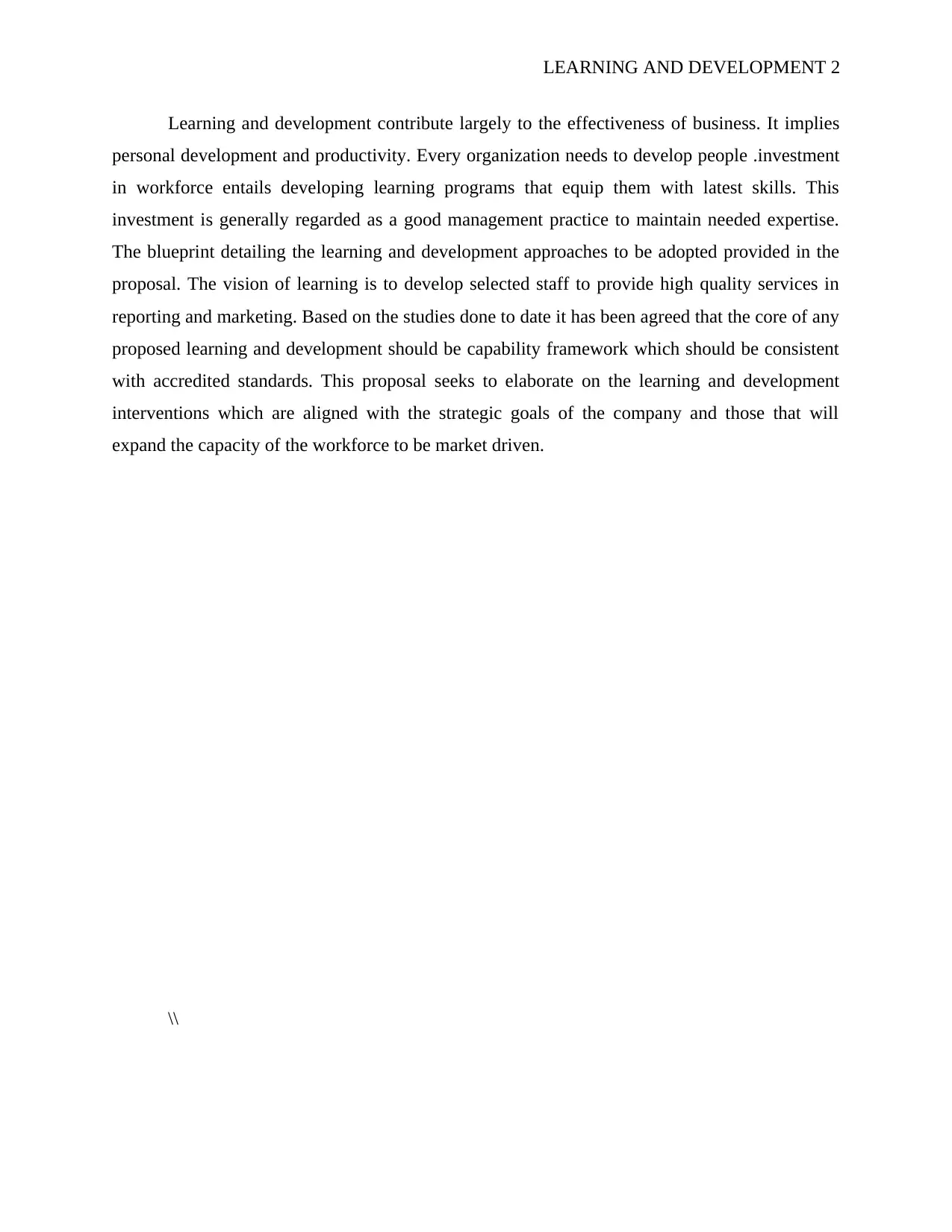
LEARNING AND DEVELOPMENT 2
Learning and development contribute largely to the effectiveness of business. It implies
personal development and productivity. Every organization needs to develop people .investment
in workforce entails developing learning programs that equip them with latest skills. This
investment is generally regarded as a good management practice to maintain needed expertise.
The blueprint detailing the learning and development approaches to be adopted provided in the
proposal. The vision of learning is to develop selected staff to provide high quality services in
reporting and marketing. Based on the studies done to date it has been agreed that the core of any
proposed learning and development should be capability framework which should be consistent
with accredited standards. This proposal seeks to elaborate on the learning and development
interventions which are aligned with the strategic goals of the company and those that will
expand the capacity of the workforce to be market driven.
\\
Learning and development contribute largely to the effectiveness of business. It implies
personal development and productivity. Every organization needs to develop people .investment
in workforce entails developing learning programs that equip them with latest skills. This
investment is generally regarded as a good management practice to maintain needed expertise.
The blueprint detailing the learning and development approaches to be adopted provided in the
proposal. The vision of learning is to develop selected staff to provide high quality services in
reporting and marketing. Based on the studies done to date it has been agreed that the core of any
proposed learning and development should be capability framework which should be consistent
with accredited standards. This proposal seeks to elaborate on the learning and development
interventions which are aligned with the strategic goals of the company and those that will
expand the capacity of the workforce to be market driven.
\\
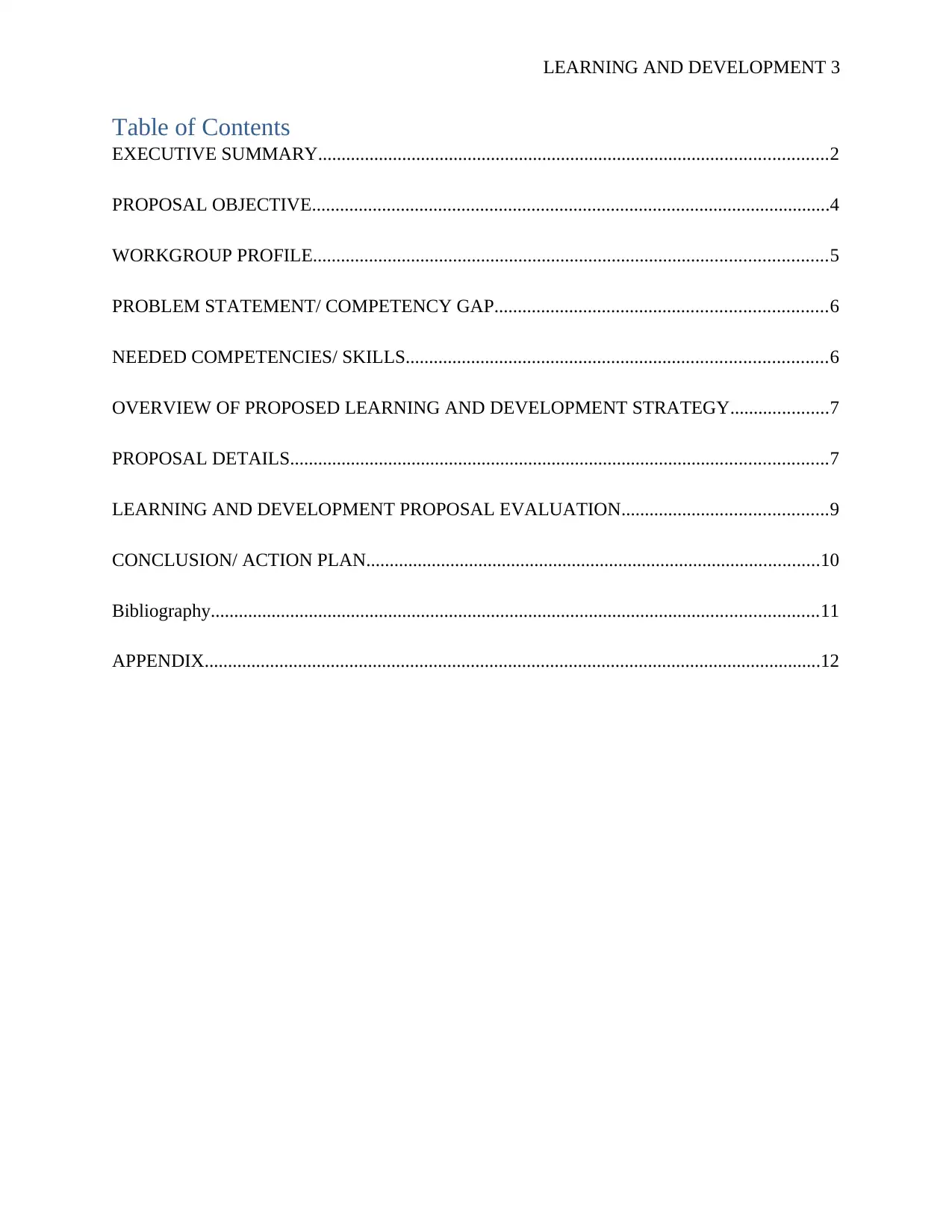
LEARNING AND DEVELOPMENT 3
Table of Contents
EXECUTIVE SUMMARY.............................................................................................................2
PROPOSAL OBJECTIVE...............................................................................................................4
WORKGROUP PROFILE..............................................................................................................5
PROBLEM STATEMENT/ COMPETENCY GAP.......................................................................6
NEEDED COMPETENCIES/ SKILLS..........................................................................................6
OVERVIEW OF PROPOSED LEARNING AND DEVELOPMENT STRATEGY.....................7
PROPOSAL DETAILS...................................................................................................................7
LEARNING AND DEVELOPMENT PROPOSAL EVALUATION............................................9
CONCLUSION/ ACTION PLAN.................................................................................................10
Bibliography..................................................................................................................................11
APPENDIX....................................................................................................................................12
Table of Contents
EXECUTIVE SUMMARY.............................................................................................................2
PROPOSAL OBJECTIVE...............................................................................................................4
WORKGROUP PROFILE..............................................................................................................5
PROBLEM STATEMENT/ COMPETENCY GAP.......................................................................6
NEEDED COMPETENCIES/ SKILLS..........................................................................................6
OVERVIEW OF PROPOSED LEARNING AND DEVELOPMENT STRATEGY.....................7
PROPOSAL DETAILS...................................................................................................................7
LEARNING AND DEVELOPMENT PROPOSAL EVALUATION............................................9
CONCLUSION/ ACTION PLAN.................................................................................................10
Bibliography..................................................................................................................................11
APPENDIX....................................................................................................................................12
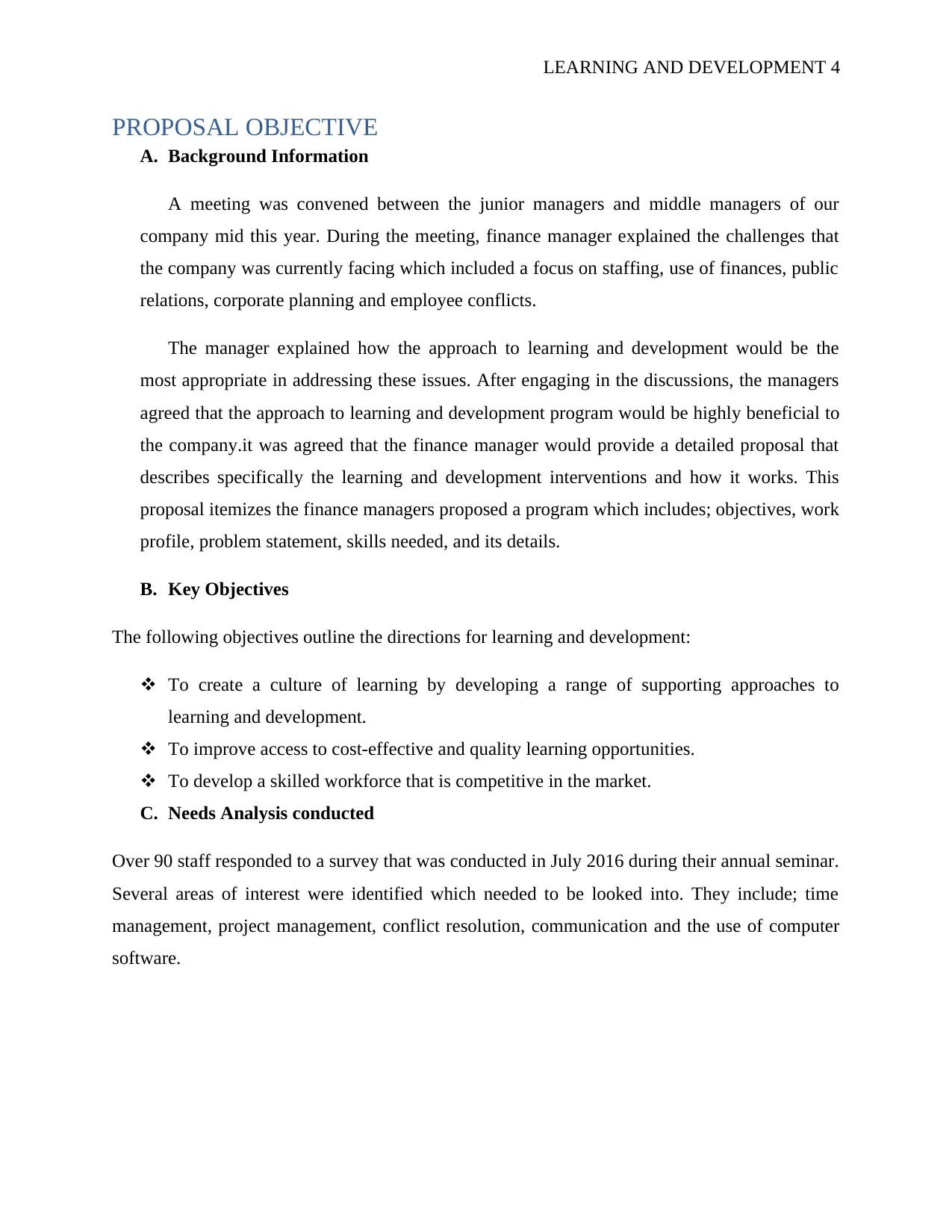
LEARNING AND DEVELOPMENT 4
PROPOSAL OBJECTIVE
A. Background Information
A meeting was convened between the junior managers and middle managers of our
company mid this year. During the meeting, finance manager explained the challenges that
the company was currently facing which included a focus on staffing, use of finances, public
relations, corporate planning and employee conflicts.
The manager explained how the approach to learning and development would be the
most appropriate in addressing these issues. After engaging in the discussions, the managers
agreed that the approach to learning and development program would be highly beneficial to
the company.it was agreed that the finance manager would provide a detailed proposal that
describes specifically the learning and development interventions and how it works. This
proposal itemizes the finance managers proposed a program which includes; objectives, work
profile, problem statement, skills needed, and its details.
B. Key Objectives
The following objectives outline the directions for learning and development:
To create a culture of learning by developing a range of supporting approaches to
learning and development.
To improve access to cost-effective and quality learning opportunities.
To develop a skilled workforce that is competitive in the market.
C. Needs Analysis conducted
Over 90 staff responded to a survey that was conducted in July 2016 during their annual seminar.
Several areas of interest were identified which needed to be looked into. They include; time
management, project management, conflict resolution, communication and the use of computer
software.
PROPOSAL OBJECTIVE
A. Background Information
A meeting was convened between the junior managers and middle managers of our
company mid this year. During the meeting, finance manager explained the challenges that
the company was currently facing which included a focus on staffing, use of finances, public
relations, corporate planning and employee conflicts.
The manager explained how the approach to learning and development would be the
most appropriate in addressing these issues. After engaging in the discussions, the managers
agreed that the approach to learning and development program would be highly beneficial to
the company.it was agreed that the finance manager would provide a detailed proposal that
describes specifically the learning and development interventions and how it works. This
proposal itemizes the finance managers proposed a program which includes; objectives, work
profile, problem statement, skills needed, and its details.
B. Key Objectives
The following objectives outline the directions for learning and development:
To create a culture of learning by developing a range of supporting approaches to
learning and development.
To improve access to cost-effective and quality learning opportunities.
To develop a skilled workforce that is competitive in the market.
C. Needs Analysis conducted
Over 90 staff responded to a survey that was conducted in July 2016 during their annual seminar.
Several areas of interest were identified which needed to be looked into. They include; time
management, project management, conflict resolution, communication and the use of computer
software.
Secure Best Marks with AI Grader
Need help grading? Try our AI Grader for instant feedback on your assignments.
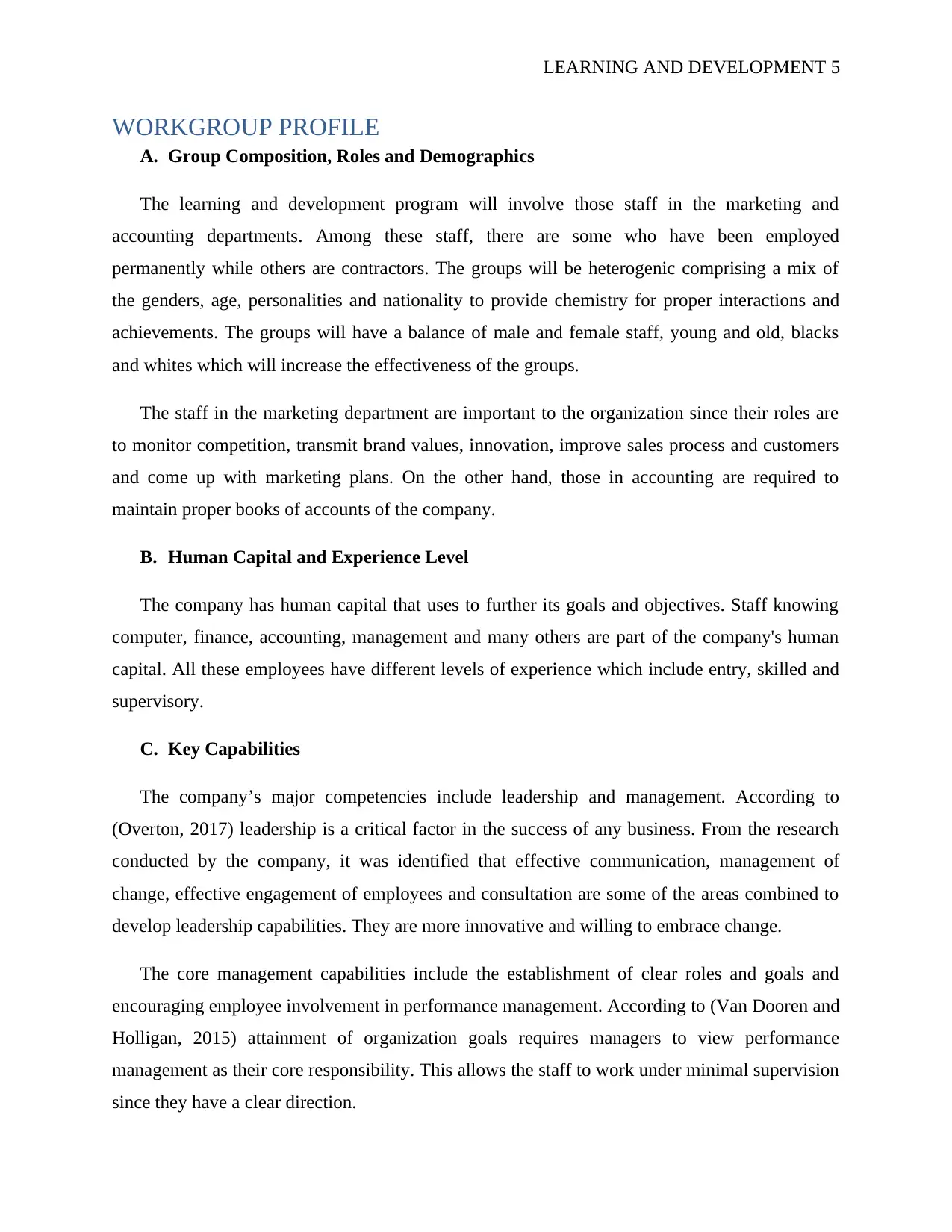
LEARNING AND DEVELOPMENT 5
WORKGROUP PROFILE
A. Group Composition, Roles and Demographics
The learning and development program will involve those staff in the marketing and
accounting departments. Among these staff, there are some who have been employed
permanently while others are contractors. The groups will be heterogenic comprising a mix of
the genders, age, personalities and nationality to provide chemistry for proper interactions and
achievements. The groups will have a balance of male and female staff, young and old, blacks
and whites which will increase the effectiveness of the groups.
The staff in the marketing department are important to the organization since their roles are
to monitor competition, transmit brand values, innovation, improve sales process and customers
and come up with marketing plans. On the other hand, those in accounting are required to
maintain proper books of accounts of the company.
B. Human Capital and Experience Level
The company has human capital that uses to further its goals and objectives. Staff knowing
computer, finance, accounting, management and many others are part of the company's human
capital. All these employees have different levels of experience which include entry, skilled and
supervisory.
C. Key Capabilities
The company’s major competencies include leadership and management. According to
(Overton, 2017) leadership is a critical factor in the success of any business. From the research
conducted by the company, it was identified that effective communication, management of
change, effective engagement of employees and consultation are some of the areas combined to
develop leadership capabilities. They are more innovative and willing to embrace change.
The core management capabilities include the establishment of clear roles and goals and
encouraging employee involvement in performance management. According to (Van Dooren and
Holligan, 2015) attainment of organization goals requires managers to view performance
management as their core responsibility. This allows the staff to work under minimal supervision
since they have a clear direction.
WORKGROUP PROFILE
A. Group Composition, Roles and Demographics
The learning and development program will involve those staff in the marketing and
accounting departments. Among these staff, there are some who have been employed
permanently while others are contractors. The groups will be heterogenic comprising a mix of
the genders, age, personalities and nationality to provide chemistry for proper interactions and
achievements. The groups will have a balance of male and female staff, young and old, blacks
and whites which will increase the effectiveness of the groups.
The staff in the marketing department are important to the organization since their roles are
to monitor competition, transmit brand values, innovation, improve sales process and customers
and come up with marketing plans. On the other hand, those in accounting are required to
maintain proper books of accounts of the company.
B. Human Capital and Experience Level
The company has human capital that uses to further its goals and objectives. Staff knowing
computer, finance, accounting, management and many others are part of the company's human
capital. All these employees have different levels of experience which include entry, skilled and
supervisory.
C. Key Capabilities
The company’s major competencies include leadership and management. According to
(Overton, 2017) leadership is a critical factor in the success of any business. From the research
conducted by the company, it was identified that effective communication, management of
change, effective engagement of employees and consultation are some of the areas combined to
develop leadership capabilities. They are more innovative and willing to embrace change.
The core management capabilities include the establishment of clear roles and goals and
encouraging employee involvement in performance management. According to (Van Dooren and
Holligan, 2015) attainment of organization goals requires managers to view performance
management as their core responsibility. This allows the staff to work under minimal supervision
since they have a clear direction.
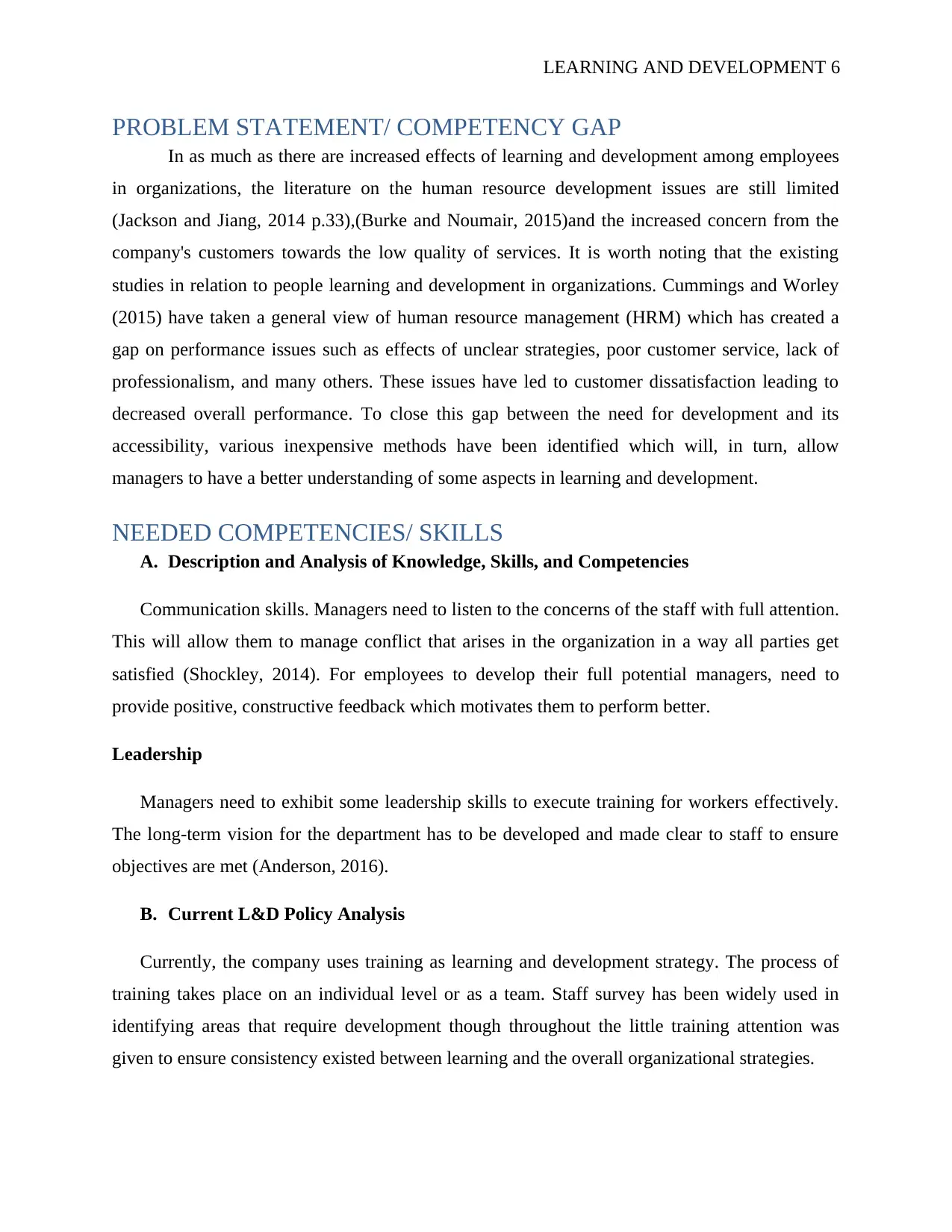
LEARNING AND DEVELOPMENT 6
PROBLEM STATEMENT/ COMPETENCY GAP
In as much as there are increased effects of learning and development among employees
in organizations, the literature on the human resource development issues are still limited
(Jackson and Jiang, 2014 p.33),(Burke and Noumair, 2015)and the increased concern from the
company's customers towards the low quality of services. It is worth noting that the existing
studies in relation to people learning and development in organizations. Cummings and Worley
(2015) have taken a general view of human resource management (HRM) which has created a
gap on performance issues such as effects of unclear strategies, poor customer service, lack of
professionalism, and many others. These issues have led to customer dissatisfaction leading to
decreased overall performance. To close this gap between the need for development and its
accessibility, various inexpensive methods have been identified which will, in turn, allow
managers to have a better understanding of some aspects in learning and development.
NEEDED COMPETENCIES/ SKILLS
A. Description and Analysis of Knowledge, Skills, and Competencies
Communication skills. Managers need to listen to the concerns of the staff with full attention.
This will allow them to manage conflict that arises in the organization in a way all parties get
satisfied (Shockley, 2014). For employees to develop their full potential managers, need to
provide positive, constructive feedback which motivates them to perform better.
Leadership
Managers need to exhibit some leadership skills to execute training for workers effectively.
The long-term vision for the department has to be developed and made clear to staff to ensure
objectives are met (Anderson, 2016).
B. Current L&D Policy Analysis
Currently, the company uses training as learning and development strategy. The process of
training takes place on an individual level or as a team. Staff survey has been widely used in
identifying areas that require development though throughout the little training attention was
given to ensure consistency existed between learning and the overall organizational strategies.
PROBLEM STATEMENT/ COMPETENCY GAP
In as much as there are increased effects of learning and development among employees
in organizations, the literature on the human resource development issues are still limited
(Jackson and Jiang, 2014 p.33),(Burke and Noumair, 2015)and the increased concern from the
company's customers towards the low quality of services. It is worth noting that the existing
studies in relation to people learning and development in organizations. Cummings and Worley
(2015) have taken a general view of human resource management (HRM) which has created a
gap on performance issues such as effects of unclear strategies, poor customer service, lack of
professionalism, and many others. These issues have led to customer dissatisfaction leading to
decreased overall performance. To close this gap between the need for development and its
accessibility, various inexpensive methods have been identified which will, in turn, allow
managers to have a better understanding of some aspects in learning and development.
NEEDED COMPETENCIES/ SKILLS
A. Description and Analysis of Knowledge, Skills, and Competencies
Communication skills. Managers need to listen to the concerns of the staff with full attention.
This will allow them to manage conflict that arises in the organization in a way all parties get
satisfied (Shockley, 2014). For employees to develop their full potential managers, need to
provide positive, constructive feedback which motivates them to perform better.
Leadership
Managers need to exhibit some leadership skills to execute training for workers effectively.
The long-term vision for the department has to be developed and made clear to staff to ensure
objectives are met (Anderson, 2016).
B. Current L&D Policy Analysis
Currently, the company uses training as learning and development strategy. The process of
training takes place on an individual level or as a team. Staff survey has been widely used in
identifying areas that require development though throughout the little training attention was
given to ensure consistency existed between learning and the overall organizational strategies.
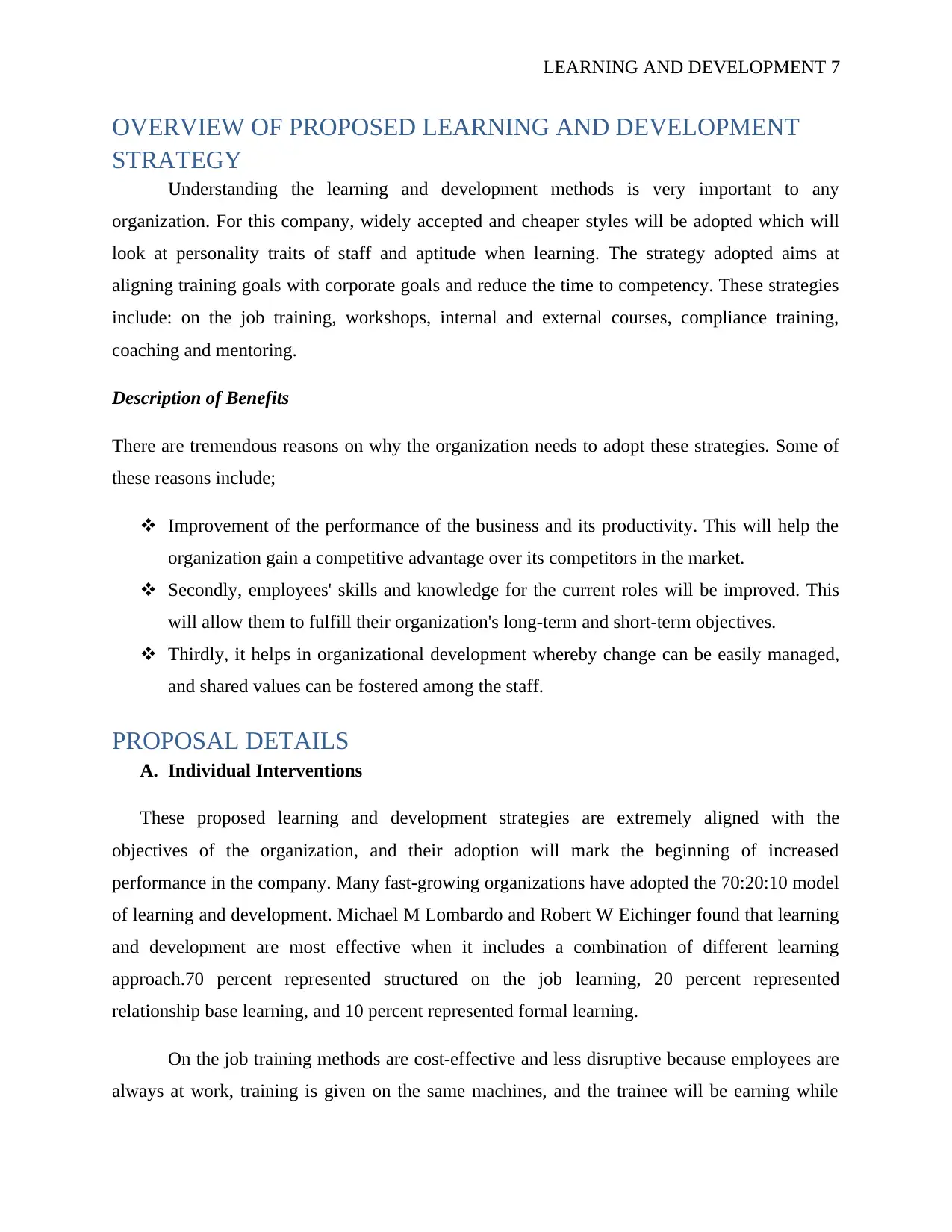
LEARNING AND DEVELOPMENT 7
OVERVIEW OF PROPOSED LEARNING AND DEVELOPMENT
STRATEGY
Understanding the learning and development methods is very important to any
organization. For this company, widely accepted and cheaper styles will be adopted which will
look at personality traits of staff and aptitude when learning. The strategy adopted aims at
aligning training goals with corporate goals and reduce the time to competency. These strategies
include: on the job training, workshops, internal and external courses, compliance training,
coaching and mentoring.
Description of Benefits
There are tremendous reasons on why the organization needs to adopt these strategies. Some of
these reasons include;
Improvement of the performance of the business and its productivity. This will help the
organization gain a competitive advantage over its competitors in the market.
Secondly, employees' skills and knowledge for the current roles will be improved. This
will allow them to fulfill their organization's long-term and short-term objectives.
Thirdly, it helps in organizational development whereby change can be easily managed,
and shared values can be fostered among the staff.
PROPOSAL DETAILS
A. Individual Interventions
These proposed learning and development strategies are extremely aligned with the
objectives of the organization, and their adoption will mark the beginning of increased
performance in the company. Many fast-growing organizations have adopted the 70:20:10 model
of learning and development. Michael M Lombardo and Robert W Eichinger found that learning
and development are most effective when it includes a combination of different learning
approach.70 percent represented structured on the job learning, 20 percent represented
relationship base learning, and 10 percent represented formal learning.
On the job training methods are cost-effective and less disruptive because employees are
always at work, training is given on the same machines, and the trainee will be earning while
OVERVIEW OF PROPOSED LEARNING AND DEVELOPMENT
STRATEGY
Understanding the learning and development methods is very important to any
organization. For this company, widely accepted and cheaper styles will be adopted which will
look at personality traits of staff and aptitude when learning. The strategy adopted aims at
aligning training goals with corporate goals and reduce the time to competency. These strategies
include: on the job training, workshops, internal and external courses, compliance training,
coaching and mentoring.
Description of Benefits
There are tremendous reasons on why the organization needs to adopt these strategies. Some of
these reasons include;
Improvement of the performance of the business and its productivity. This will help the
organization gain a competitive advantage over its competitors in the market.
Secondly, employees' skills and knowledge for the current roles will be improved. This
will allow them to fulfill their organization's long-term and short-term objectives.
Thirdly, it helps in organizational development whereby change can be easily managed,
and shared values can be fostered among the staff.
PROPOSAL DETAILS
A. Individual Interventions
These proposed learning and development strategies are extremely aligned with the
objectives of the organization, and their adoption will mark the beginning of increased
performance in the company. Many fast-growing organizations have adopted the 70:20:10 model
of learning and development. Michael M Lombardo and Robert W Eichinger found that learning
and development are most effective when it includes a combination of different learning
approach.70 percent represented structured on the job learning, 20 percent represented
relationship base learning, and 10 percent represented formal learning.
On the job training methods are cost-effective and less disruptive because employees are
always at work, training is given on the same machines, and the trainee will be earning while
Paraphrase This Document
Need a fresh take? Get an instant paraphrase of this document with our AI Paraphraser
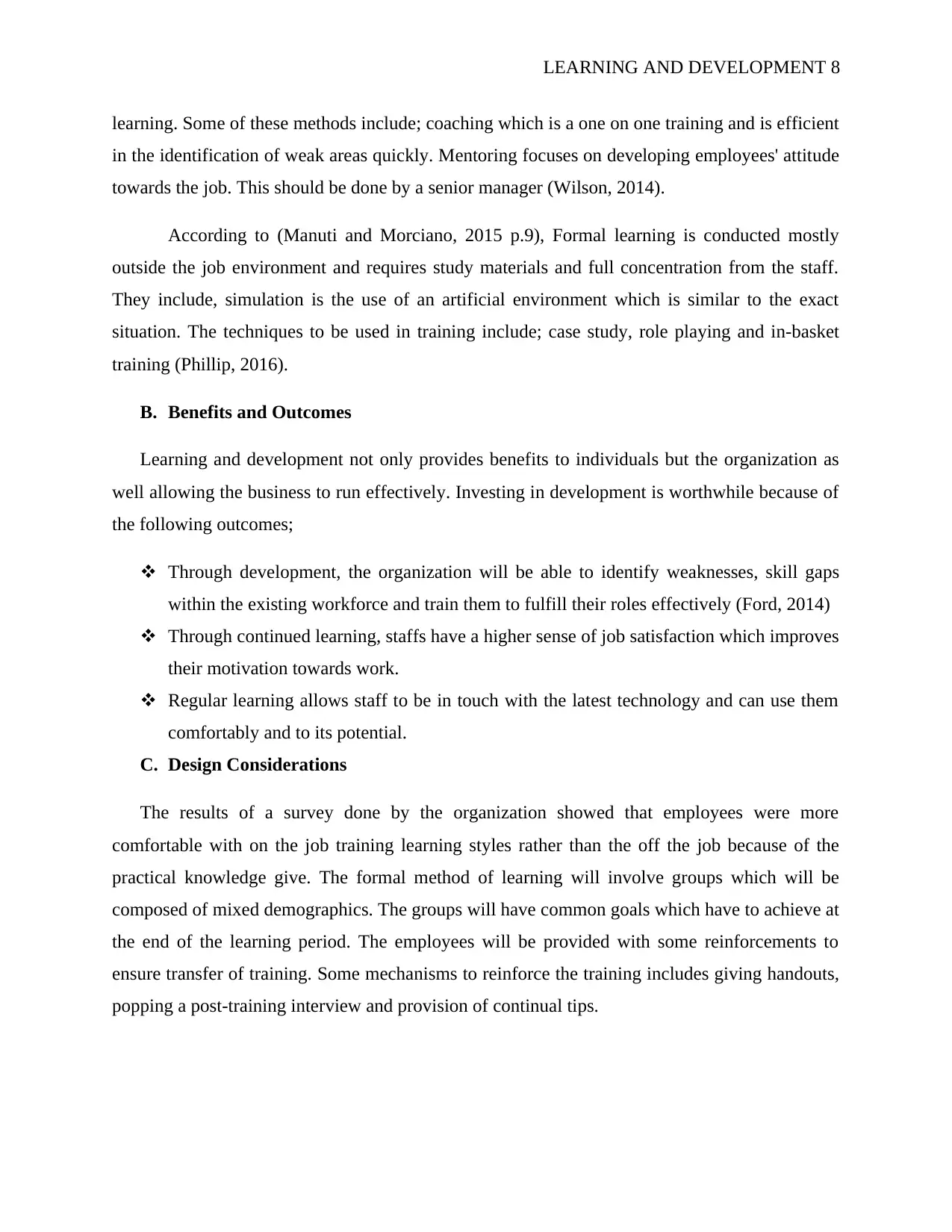
LEARNING AND DEVELOPMENT 8
learning. Some of these methods include; coaching which is a one on one training and is efficient
in the identification of weak areas quickly. Mentoring focuses on developing employees' attitude
towards the job. This should be done by a senior manager (Wilson, 2014).
According to (Manuti and Morciano, 2015 p.9), Formal learning is conducted mostly
outside the job environment and requires study materials and full concentration from the staff.
They include, simulation is the use of an artificial environment which is similar to the exact
situation. The techniques to be used in training include; case study, role playing and in-basket
training (Phillip, 2016).
B. Benefits and Outcomes
Learning and development not only provides benefits to individuals but the organization as
well allowing the business to run effectively. Investing in development is worthwhile because of
the following outcomes;
Through development, the organization will be able to identify weaknesses, skill gaps
within the existing workforce and train them to fulfill their roles effectively (Ford, 2014)
Through continued learning, staffs have a higher sense of job satisfaction which improves
their motivation towards work.
Regular learning allows staff to be in touch with the latest technology and can use them
comfortably and to its potential.
C. Design Considerations
The results of a survey done by the organization showed that employees were more
comfortable with on the job training learning styles rather than the off the job because of the
practical knowledge give. The formal method of learning will involve groups which will be
composed of mixed demographics. The groups will have common goals which have to achieve at
the end of the learning period. The employees will be provided with some reinforcements to
ensure transfer of training. Some mechanisms to reinforce the training includes giving handouts,
popping a post-training interview and provision of continual tips.
learning. Some of these methods include; coaching which is a one on one training and is efficient
in the identification of weak areas quickly. Mentoring focuses on developing employees' attitude
towards the job. This should be done by a senior manager (Wilson, 2014).
According to (Manuti and Morciano, 2015 p.9), Formal learning is conducted mostly
outside the job environment and requires study materials and full concentration from the staff.
They include, simulation is the use of an artificial environment which is similar to the exact
situation. The techniques to be used in training include; case study, role playing and in-basket
training (Phillip, 2016).
B. Benefits and Outcomes
Learning and development not only provides benefits to individuals but the organization as
well allowing the business to run effectively. Investing in development is worthwhile because of
the following outcomes;
Through development, the organization will be able to identify weaknesses, skill gaps
within the existing workforce and train them to fulfill their roles effectively (Ford, 2014)
Through continued learning, staffs have a higher sense of job satisfaction which improves
their motivation towards work.
Regular learning allows staff to be in touch with the latest technology and can use them
comfortably and to its potential.
C. Design Considerations
The results of a survey done by the organization showed that employees were more
comfortable with on the job training learning styles rather than the off the job because of the
practical knowledge give. The formal method of learning will involve groups which will be
composed of mixed demographics. The groups will have common goals which have to achieve at
the end of the learning period. The employees will be provided with some reinforcements to
ensure transfer of training. Some mechanisms to reinforce the training includes giving handouts,
popping a post-training interview and provision of continual tips.
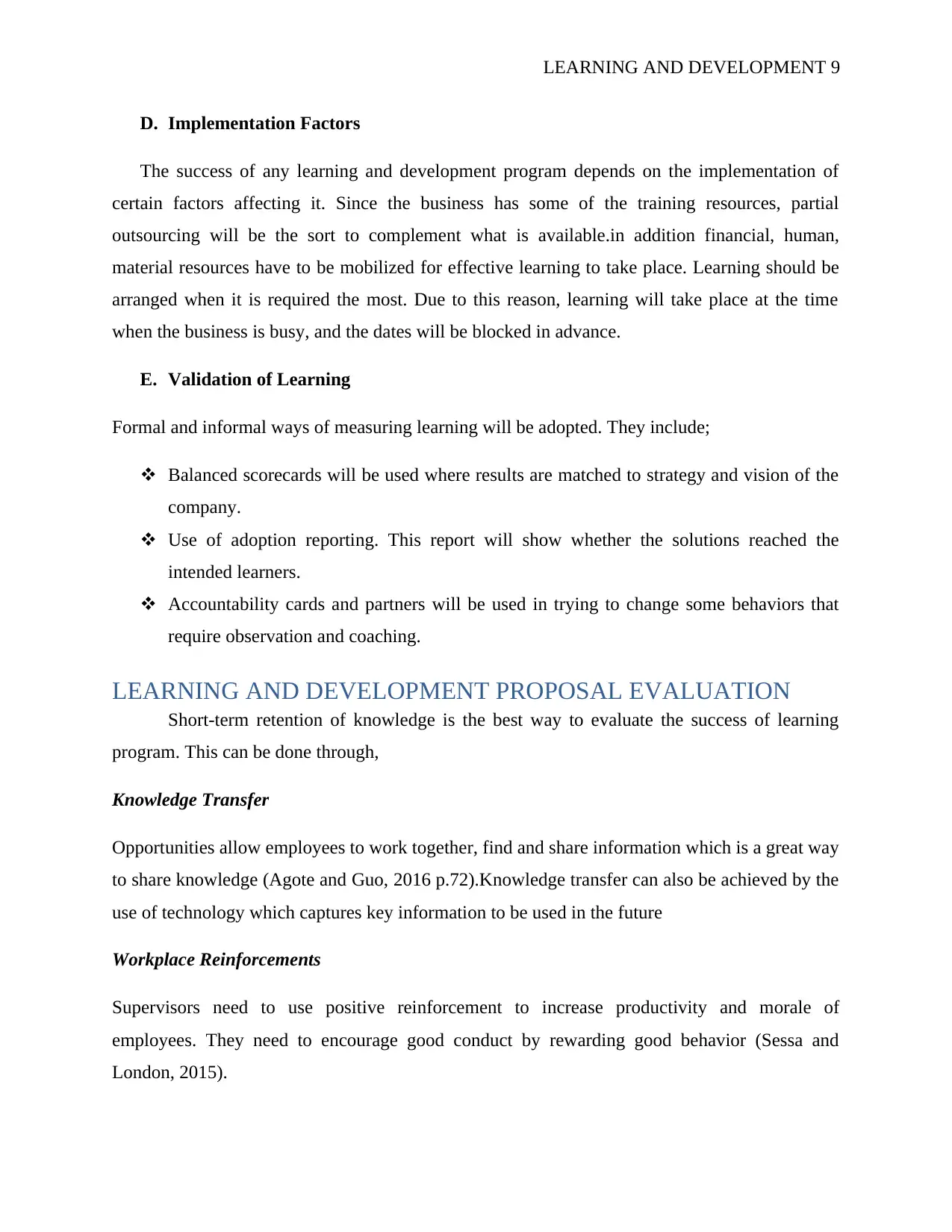
LEARNING AND DEVELOPMENT 9
D. Implementation Factors
The success of any learning and development program depends on the implementation of
certain factors affecting it. Since the business has some of the training resources, partial
outsourcing will be the sort to complement what is available.in addition financial, human,
material resources have to be mobilized for effective learning to take place. Learning should be
arranged when it is required the most. Due to this reason, learning will take place at the time
when the business is busy, and the dates will be blocked in advance.
E. Validation of Learning
Formal and informal ways of measuring learning will be adopted. They include;
Balanced scorecards will be used where results are matched to strategy and vision of the
company.
Use of adoption reporting. This report will show whether the solutions reached the
intended learners.
Accountability cards and partners will be used in trying to change some behaviors that
require observation and coaching.
LEARNING AND DEVELOPMENT PROPOSAL EVALUATION
Short-term retention of knowledge is the best way to evaluate the success of learning
program. This can be done through,
Knowledge Transfer
Opportunities allow employees to work together, find and share information which is a great way
to share knowledge (Agote and Guo, 2016 p.72).Knowledge transfer can also be achieved by the
use of technology which captures key information to be used in the future
Workplace Reinforcements
Supervisors need to use positive reinforcement to increase productivity and morale of
employees. They need to encourage good conduct by rewarding good behavior (Sessa and
London, 2015).
D. Implementation Factors
The success of any learning and development program depends on the implementation of
certain factors affecting it. Since the business has some of the training resources, partial
outsourcing will be the sort to complement what is available.in addition financial, human,
material resources have to be mobilized for effective learning to take place. Learning should be
arranged when it is required the most. Due to this reason, learning will take place at the time
when the business is busy, and the dates will be blocked in advance.
E. Validation of Learning
Formal and informal ways of measuring learning will be adopted. They include;
Balanced scorecards will be used where results are matched to strategy and vision of the
company.
Use of adoption reporting. This report will show whether the solutions reached the
intended learners.
Accountability cards and partners will be used in trying to change some behaviors that
require observation and coaching.
LEARNING AND DEVELOPMENT PROPOSAL EVALUATION
Short-term retention of knowledge is the best way to evaluate the success of learning
program. This can be done through,
Knowledge Transfer
Opportunities allow employees to work together, find and share information which is a great way
to share knowledge (Agote and Guo, 2016 p.72).Knowledge transfer can also be achieved by the
use of technology which captures key information to be used in the future
Workplace Reinforcements
Supervisors need to use positive reinforcement to increase productivity and morale of
employees. They need to encourage good conduct by rewarding good behavior (Sessa and
London, 2015).
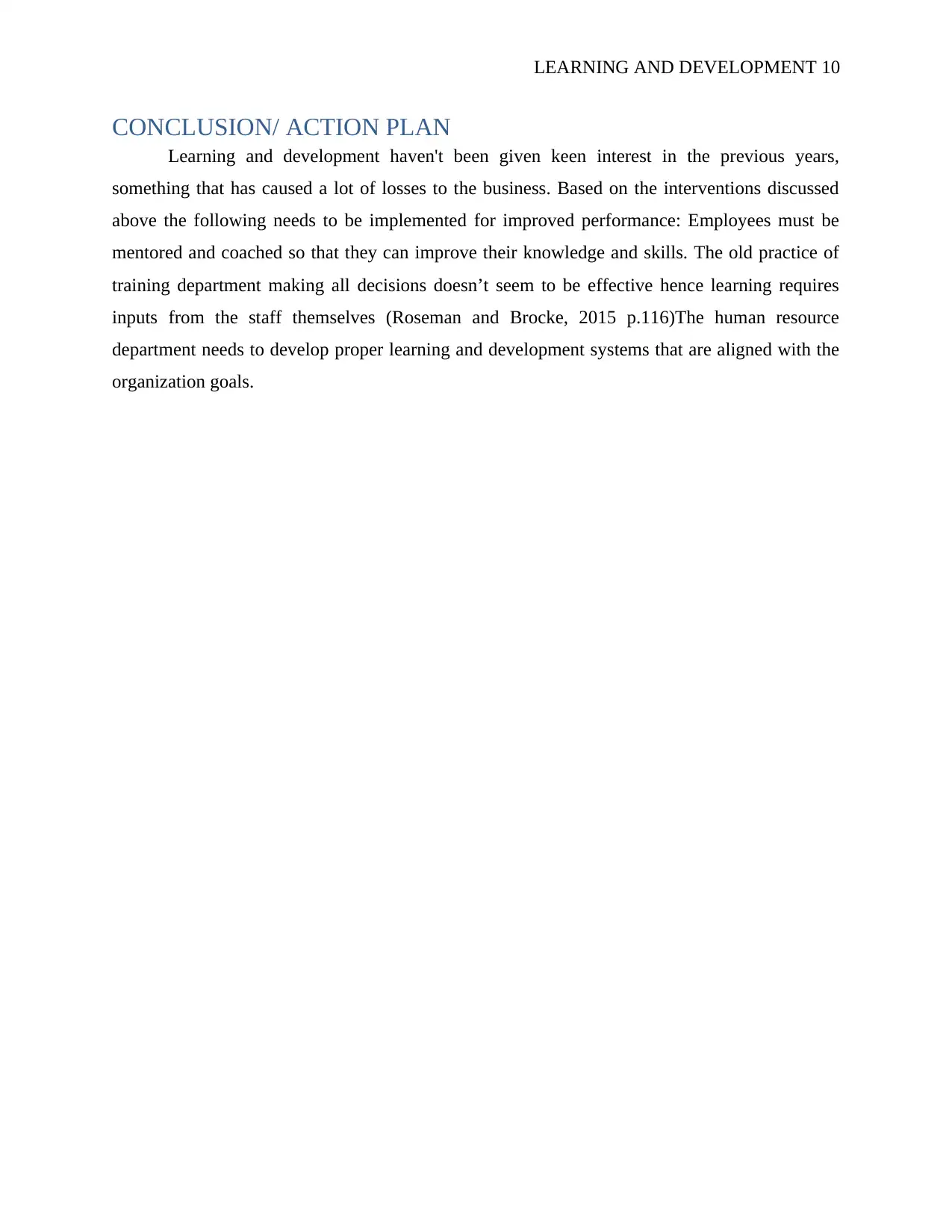
LEARNING AND DEVELOPMENT 10
CONCLUSION/ ACTION PLAN
Learning and development haven't been given keen interest in the previous years,
something that has caused a lot of losses to the business. Based on the interventions discussed
above the following needs to be implemented for improved performance: Employees must be
mentored and coached so that they can improve their knowledge and skills. The old practice of
training department making all decisions doesn’t seem to be effective hence learning requires
inputs from the staff themselves (Roseman and Brocke, 2015 p.116)The human resource
department needs to develop proper learning and development systems that are aligned with the
organization goals.
CONCLUSION/ ACTION PLAN
Learning and development haven't been given keen interest in the previous years,
something that has caused a lot of losses to the business. Based on the interventions discussed
above the following needs to be implemented for improved performance: Employees must be
mentored and coached so that they can improve their knowledge and skills. The old practice of
training department making all decisions doesn’t seem to be effective hence learning requires
inputs from the staff themselves (Roseman and Brocke, 2015 p.116)The human resource
department needs to develop proper learning and development systems that are aligned with the
organization goals.
Secure Best Marks with AI Grader
Need help grading? Try our AI Grader for instant feedback on your assignments.
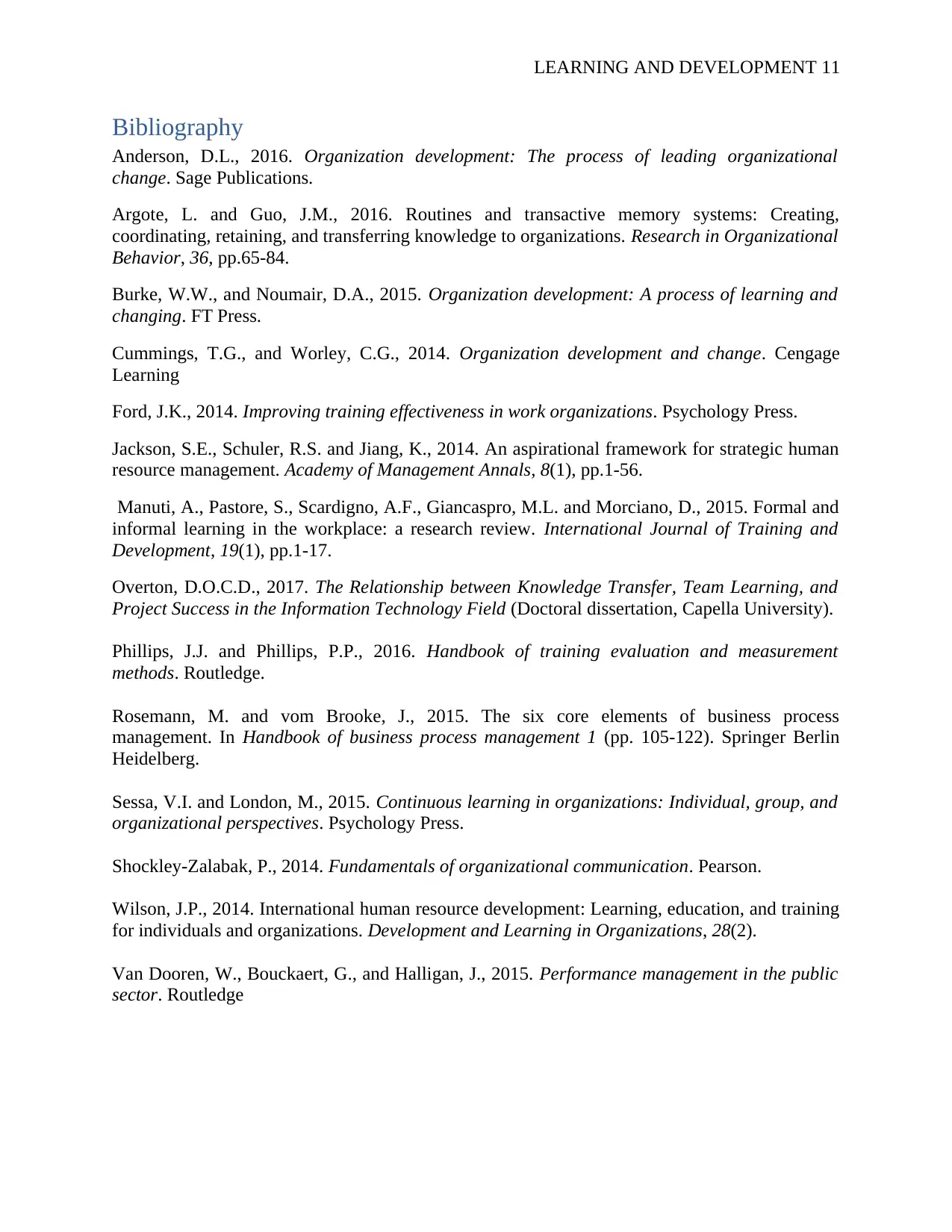
LEARNING AND DEVELOPMENT 11
Bibliography
Anderson, D.L., 2016. Organization development: The process of leading organizational
change. Sage Publications.
Argote, L. and Guo, J.M., 2016. Routines and transactive memory systems: Creating,
coordinating, retaining, and transferring knowledge to organizations. Research in Organizational
Behavior, 36, pp.65-84.
Burke, W.W., and Noumair, D.A., 2015. Organization development: A process of learning and
changing. FT Press.
Cummings, T.G., and Worley, C.G., 2014. Organization development and change. Cengage
Learning
Ford, J.K., 2014. Improving training effectiveness in work organizations. Psychology Press.
Jackson, S.E., Schuler, R.S. and Jiang, K., 2014. An aspirational framework for strategic human
resource management. Academy of Management Annals, 8(1), pp.1-56.
Manuti, A., Pastore, S., Scardigno, A.F., Giancaspro, M.L. and Morciano, D., 2015. Formal and
informal learning in the workplace: a research review. International Journal of Training and
Development, 19(1), pp.1-17.
Overton, D.O.C.D., 2017. The Relationship between Knowledge Transfer, Team Learning, and
Project Success in the Information Technology Field (Doctoral dissertation, Capella University).
Phillips, J.J. and Phillips, P.P., 2016. Handbook of training evaluation and measurement
methods. Routledge.
Rosemann, M. and vom Brooke, J., 2015. The six core elements of business process
management. In Handbook of business process management 1 (pp. 105-122). Springer Berlin
Heidelberg.
Sessa, V.I. and London, M., 2015. Continuous learning in organizations: Individual, group, and
organizational perspectives. Psychology Press.
Shockley-Zalabak, P., 2014. Fundamentals of organizational communication. Pearson.
Wilson, J.P., 2014. International human resource development: Learning, education, and training
for individuals and organizations. Development and Learning in Organizations, 28(2).
Van Dooren, W., Bouckaert, G., and Halligan, J., 2015. Performance management in the public
sector. Routledge
Bibliography
Anderson, D.L., 2016. Organization development: The process of leading organizational
change. Sage Publications.
Argote, L. and Guo, J.M., 2016. Routines and transactive memory systems: Creating,
coordinating, retaining, and transferring knowledge to organizations. Research in Organizational
Behavior, 36, pp.65-84.
Burke, W.W., and Noumair, D.A., 2015. Organization development: A process of learning and
changing. FT Press.
Cummings, T.G., and Worley, C.G., 2014. Organization development and change. Cengage
Learning
Ford, J.K., 2014. Improving training effectiveness in work organizations. Psychology Press.
Jackson, S.E., Schuler, R.S. and Jiang, K., 2014. An aspirational framework for strategic human
resource management. Academy of Management Annals, 8(1), pp.1-56.
Manuti, A., Pastore, S., Scardigno, A.F., Giancaspro, M.L. and Morciano, D., 2015. Formal and
informal learning in the workplace: a research review. International Journal of Training and
Development, 19(1), pp.1-17.
Overton, D.O.C.D., 2017. The Relationship between Knowledge Transfer, Team Learning, and
Project Success in the Information Technology Field (Doctoral dissertation, Capella University).
Phillips, J.J. and Phillips, P.P., 2016. Handbook of training evaluation and measurement
methods. Routledge.
Rosemann, M. and vom Brooke, J., 2015. The six core elements of business process
management. In Handbook of business process management 1 (pp. 105-122). Springer Berlin
Heidelberg.
Sessa, V.I. and London, M., 2015. Continuous learning in organizations: Individual, group, and
organizational perspectives. Psychology Press.
Shockley-Zalabak, P., 2014. Fundamentals of organizational communication. Pearson.
Wilson, J.P., 2014. International human resource development: Learning, education, and training
for individuals and organizations. Development and Learning in Organizations, 28(2).
Van Dooren, W., Bouckaert, G., and Halligan, J., 2015. Performance management in the public
sector. Routledge
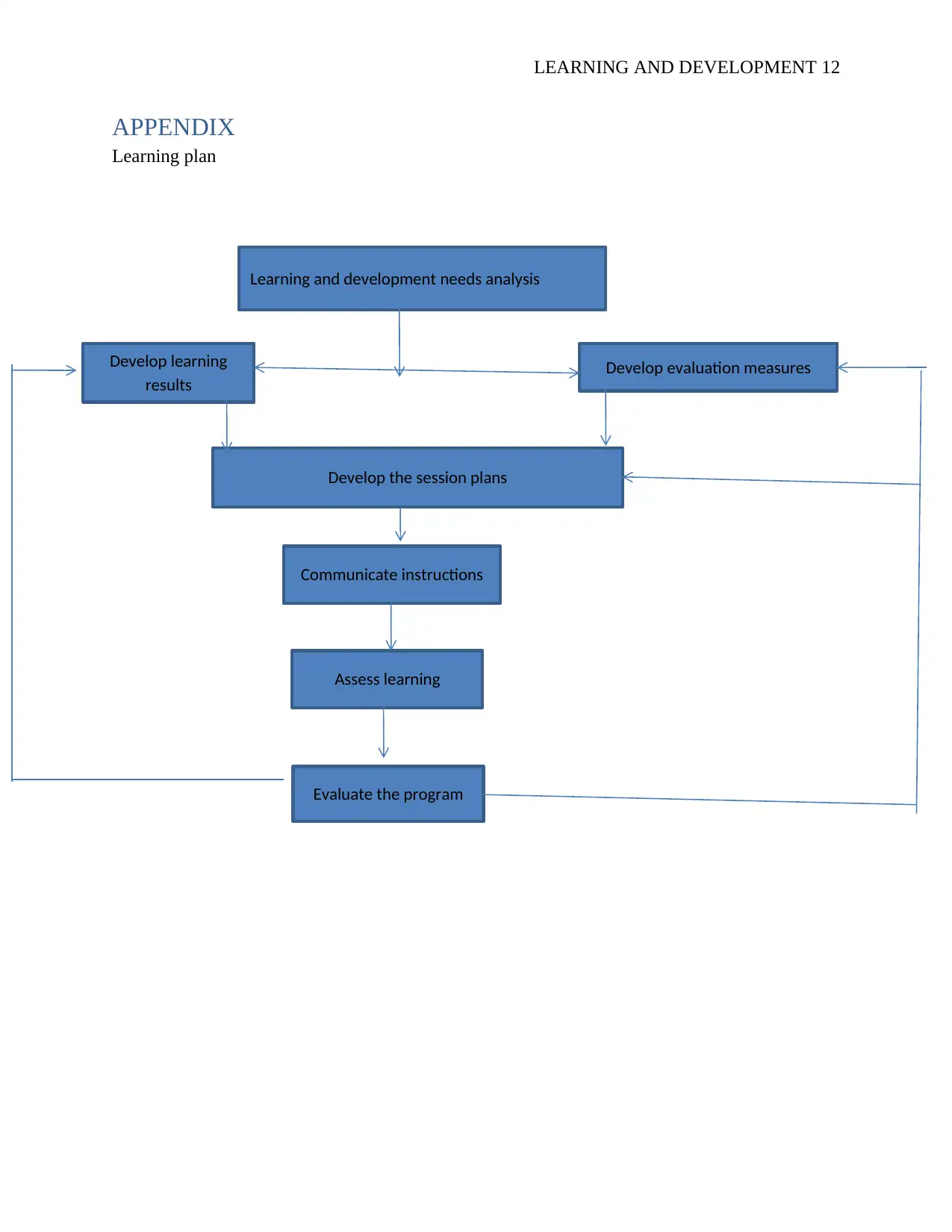
LEARNING AND DEVELOPMENT 12
APPENDIX
Learning plan
Learning and development needs analysis
Develop learning
results
Develop the session plans
Develop evaluation measures
Communicate instructions
Assess learning
Evaluate the program
APPENDIX
Learning plan
Learning and development needs analysis
Develop learning
results
Develop the session plans
Develop evaluation measures
Communicate instructions
Assess learning
Evaluate the program
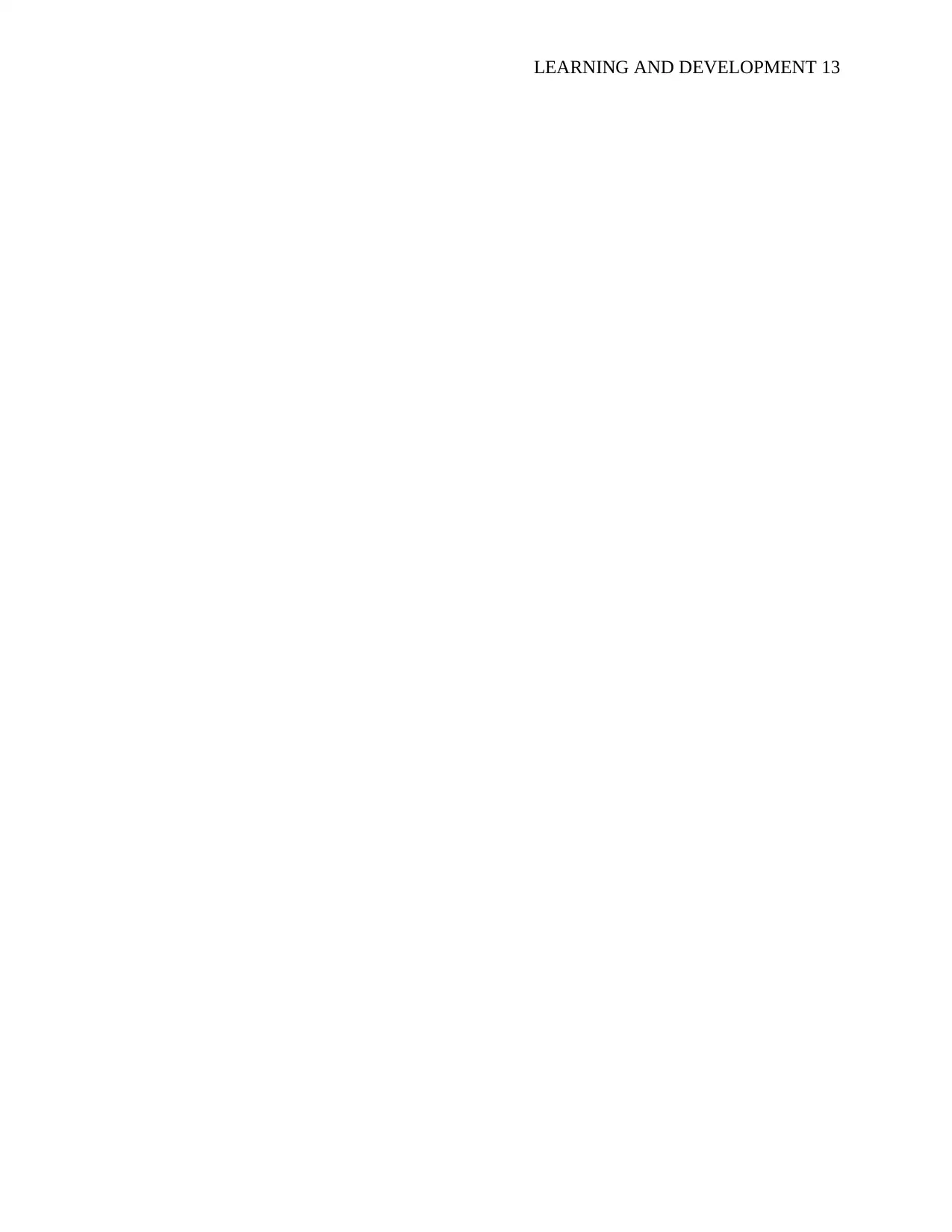
LEARNING AND DEVELOPMENT 13
1 out of 13
Related Documents
Your All-in-One AI-Powered Toolkit for Academic Success.
+13062052269
info@desklib.com
Available 24*7 on WhatsApp / Email
![[object Object]](/_next/static/media/star-bottom.7253800d.svg)
Unlock your academic potential
© 2024 | Zucol Services PVT LTD | All rights reserved.




